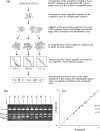Accurate measurement of the relative abundance of different DNA species in complex DNA mixtures
- PMID: 22334570
- PMCID: PMC3372371
- DOI: 10.1093/dnares/dss002
Accurate measurement of the relative abundance of different DNA species in complex DNA mixtures
Abstract
A molecular tool that can compare the abundances of different DNA sequences is necessary for comparing intergenic or interspecific gene expression. We devised and verified such a tool using a quantitative competitive polymerase chain reaction approach. For this approach, we adapted a competitor array, an artificially made plasmid DNA in which all the competitor templates for the target DNAs are arranged with a defined ratio, and melting analysis for allele quantitation for accurate quantitation of the fractional ratios of competitively amplified DNAs. Assays on two sets of DNA mixtures with explicitly known compositional structures of the test sequences were performed. The resultant average relative errors of 0.059 and 0.021 emphasize the highly accurate nature of this method. Furthermore, the method's capability of obtaining biological data is demonstrated by the fact that it can illustrate the tissue-specific quantitative expression signatures of the three housekeeping genes G6pdx, Ubc, and Rps27 by using the forms of the relative abundances of their transcripts, and the differential preferences of Igf2 enhancers for each of the multiple Igf2 promoters for the transcription.
Figures



Similar articles
-
Quantitative assessment of the human TCRBV repertoire by competitive PCR.J Immunol Methods. 1996 Aug 14;194(2):155-68. doi: 10.1016/0022-1759(96)00082-8. J Immunol Methods. 1996. PMID: 8765169
-
The 5' flank of mouse H19 in an unusual chromatin conformation unidirectionally blocks enhancer-promoter communication.Curr Biol. 2000 Apr 20;10(8):449-57. doi: 10.1016/s0960-9822(00)00442-5. Curr Biol. 2000. PMID: 10801414
-
Relative quantitation of restriction fragment length polymorphic DNAs via DNA melting analysis provides an effective way to determine allele frequencies.Genomics. 2009 Nov;94(5):355-61. doi: 10.1016/j.ygeno.2009.08.004. Epub 2009 Aug 15. Genomics. 2009. PMID: 19686835
-
Quantitation of host cell DNA contaminate in pharmaceutical-grade plasmid DNA using competitive polymerase chain reaction and enzyme-linked immunosorbent assay.Hum Gene Ther. 1998 May 20;9(8):1173-80. doi: 10.1089/hum.1998.9.8-1173. Hum Gene Ther. 1998. PMID: 9625256
-
The human insulin-like growth factor-II promoter P1 is not restricted to liver: evidence for expression of P1 in other tissues and for a homologous promoter in baboon liver.Horm Metab Res. 1995 Oct;27(10):447-9. doi: 10.1055/s-2007-979999. Horm Metab Res. 1995. PMID: 8575722
Cited by
-
SiNG-PCRseq: Accurate inter-sequence quantification achieved by spiking-in a neighbor genome for competitive PCR amplicon sequencing.Sci Rep. 2015 Jul 6;5:11879. doi: 10.1038/srep11879. Sci Rep. 2015. PMID: 26144254 Free PMC article.
References
-
- Schena M., Shalon D., Davis R.W., Brown P.O. Quantitative monitoring of gene expression patterns with a complementary DNA microarray. Science. 1995;270:467–70. - PubMed
Publication types
MeSH terms
Substances
LinkOut - more resources
Full Text Sources
Other Literature Sources
Miscellaneous

